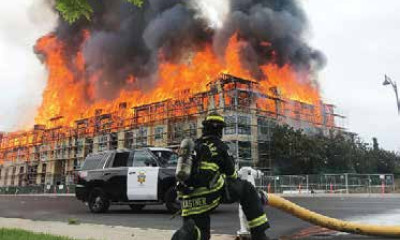A Private Adjuster's Perspective: Policy Limits and Co-Insurance Clauses

Policy Limits and Co-Insurance Clauses
Helping your client avoid painful insurance claim penalties
As trusted advisors, part of our job is to offer our clients helpful insights to assist in their success. While we are glad to do this, some requests can turn out to be more challenging than others. For instance, if you have practiced long enough, you will likely be asked by a client to "fix something" after they made a costly assumption.
One type of transaction in which clients often make costly assumptions is in procuring business insurance. As a contract to insure, an insurance policy is a negotiable legal document. It is important that your client recognize that there are provisions within policies that can compromise a future claim settlement.
An Inherently Shaky Stage
Your client's insurance agent is tasked with finding the right balance between adequate coverage and a premium amount your client is willing to pay. After all, the insurance agent is in the business of selling insurance.
There are a couple of common ways that agents can reduce coverage premiums: one is by establishing a lower policy limit. While this may reduce the premium, there is a big caveat. The policy will likely contain a co-insurance clause. If your client does not fully understand how co-insurance works it may adversely impact a future claim.
Understanding Co-Insurance
The co-insurance clause a provision that is frequently inserted into insurance policies in an effort to counteract lowered insurance limits. Co-insurance is a clause that states the policyholder will share in the amount of the loss, should adequate limits of coverage not be in place at the time of the loss. It is essentially a penalty for not insuring to value. The computation used to determine compliance and penalties is frequently misunderstood. If your client is offered a co-insurance clause, it is advisable that you help them understand how this clause will impact any claims they may have before coverage is placed. The formula for co-insurance recovery is:
(Value of Insurance Carried/ Value of Insurance Required) x Compensable Amount of the Loss
Unless the amount of insurance in place is enough to comply with the co-insurance clause, your client could be receiving less of a payout than anticipated.
Questions to Ask in Establishing a Policy Limit
A proactive conversation on co-insurance can help your client to see past the cost of buying insurance to make sure they are protected.
Some carriers will establish values (policy limits) using their own means and methods, but most rely on the insured and their agent to provide values. It is important that your client think deeper about their business when working with their agent. You, as their trusted advisor, can help to provide all relevant documentation to paint an accurate coverage picture. Below are some helpful question to consider:
- How much would it cost to rebuild the structure (not the market value)?
- How much would it cost to replace of my business personal property?
- If the business was shut down completely for one year, how much income would be lost?
- Are there any changes planned in the coming year that will increase the value of the building or business personal property? Is income projected to increase?
The bottom line: it is a critical business practice for your client to portray their business as accurately as possible to their agent and to truly understand the coverage they are putting in place.
THE CO-INSURANCE CLAUSE/PENALTY
Featured Case Study
Able Corporation is a manufacturer of widgets. It owns a facility that includes machinery that is bolted to the building and permanently installed equipment such as electrical and plumbing lines, exhaust systems, etc. Able also maintains machinery which, even though bolted to the building’s floor, is self-sustaining and moveable from one building to another with relative ease.
On January 1, 2021, Able’s facility was partially damaged by fire. The estimated cost of repairing the damage was $500,000. At the time of the fire, the estimated replacement cost of the building, had it been totally destroyed, was $1.5 million. The building was insured for $1 million with a $1,000 deductible.
A few years ago, in order to save money on insurance premiums, Able had agreed to accept a 90% co-insurance provision. The relevant provision of its policy provided that the insurance carrier would not pay the full amount of any loss if the value of the covered property at the time of loss, multiplied by the co-insurance percentage shown for it in the declarations, was greater than the limit for the property.
The calculations for payment (e.g., the maximum amount that the insurance company would pay) provided in the policy were as follows:
- The value of the covered property at the time of loss x the co-insurance percentage
- The limit of insurance on the property divided by the amount determined in Step 1
- The total amount of loss (before the application of any deductible) multiplied by the amount determined in Step 2
- The amount determined in Step 3, minus the deductible
The policy stated that the insurance company would pay the amount determined in Step 4 or the limit of insurance, whichever was less. For the remainder, Able would either have to rely on other insurance or absorb the loss.
Based on this formula, the adjuster for the insurance company determined the amount of Able’s compensable loss to be $369,000 and the remaining amount of $131,000 to be paid by Able. The carrier’s adjuster made these calculations by following the four steps outlined in the co-insurance clause:
Step (1): “value of covered property” ($1.5 million) x “co-insurance percentage” (90%) = $1,350,000
Step (2): “the limit of insurance” ($1 million) divided by “the figure determined in step 1” ($1,350,000) = 74%
Step (3): “the total amount of the loss” ($500,000) multiplied by the figure determined in step 2” (74%) = $370,000
Step (4): “the figure determined in step 3” ($370,000) minus “the deductible” ($1,000) = $369,000
After being hired by Able, The Greenspan Co./Adjusters International secured a total compensation of $499,000 (excluding a $1,000 deductible) for the loss. Several different techniques were used by The Greenspan Co./Adjusters International to obtain this most welcome result.
Elimination of non-covered property: Able’s policy, in pertinent part, provided that covered property does not include the cost of excavations, grading, backfilling, or filling; foundations of buildings; or underground pipes, flues, or drains.
Since the items delineated above are “property not covered” and the co-insurance clause only references the “value of covered property,” The Greenspan Co./Adjusters International argued that the cost of replacing this non-covered property (estimated to be $150,000) cannot be included in the calculation of the penalty.
Winning this argument, the revised calculation looked like this:
Step (1): $1,350,000 (value of covered property) x 90% = $1,215,000 required
Step (2): $1 million (limit of insurance)/$1,215,000 (required) = 82%
Steps (3 and 4): $500,000 (amount of loss) x 82% equals $410,000 minus $1,000 (deductible) = $409,000 insurance recovery
But there’s more…
In making his computation of loss, the insurer’s adjuster concluded that the physical structure and all the bolted-down machinery were part of the building, with a total replacement cost of $1.5 million.
The Greenspan Co./Adjusters International contested this conclusion and countered that some of the machinery (to the tune of $200,000) was easily removable and should, therefore, be considered business personal property and not building items.
Prevailing with this winning argument, the revised calculation looked like this:
Step (1): $1,150,000 (value of covered property) x 90% = $1,035,000
Step (2): $1 million (amount of insurance)/$1,035,000 (amount required) = 96.6%
Steps (3 and 4): $500,000 (amount of loss) x 96.6% = $483,000 minus $1,000 (deductible) = $482,000 insurance recovery
In conclusion, The Greenspan Co./Adjusters International team, using their analytical skills and experience of over 75 years dealing with insurance policies and their complicated provisions, was successful in increasing Able’s recovery from the original offer of $369,000 to $482,000.





